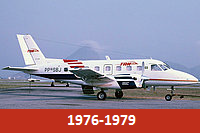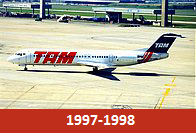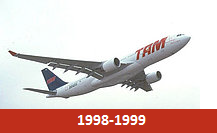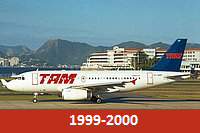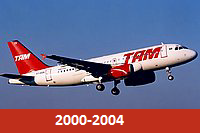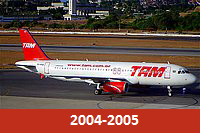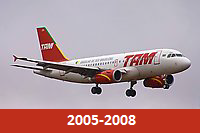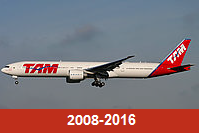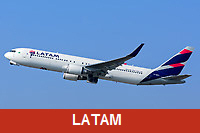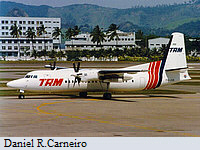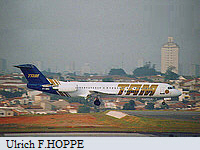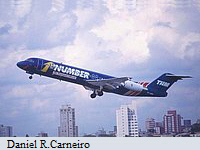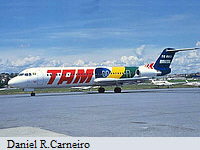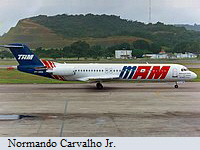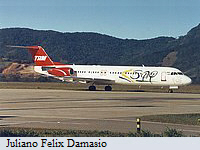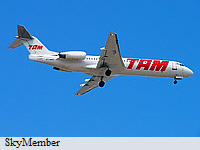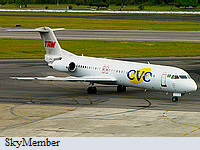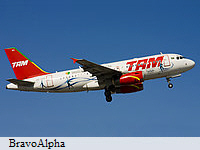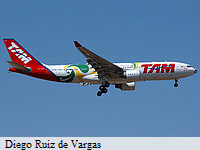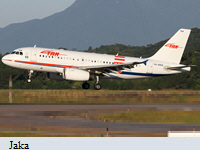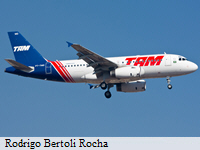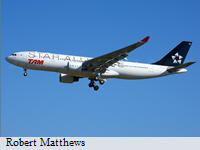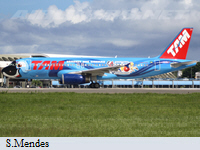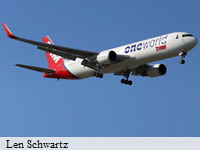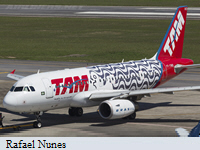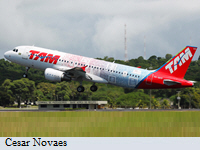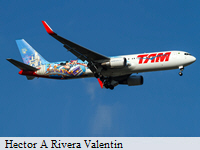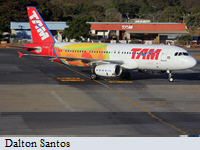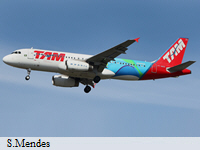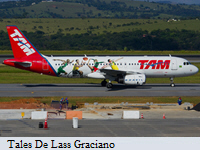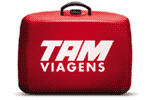In 1975 the government created SITAR and established that five regional airline would operate in five different regions of the country. Thus TAM Regional was created by Rolim Amaro to serve Mato Grosso do Sul, Mato Grosso and São Paulo. TAM Regional was formed as a joint-venture with Vasp which paid for the aircraft and airport facilities. The airline began operations with six EMB-110 in July 1976.
In January 1980 came the first of seven Fokker F-27 and TAM Regional began to connect the main domestic airports: Congonhas, Pampulha and Santos Dumont.
In 1986 Tam Regional bought Votec and renamed it to Brasil Central, also known as BR Central. So Tam Regional expanded it network to Brazil's Midwest and Northern. Rolim Amaro insisted that Tam should be known by its high quality and service. In 1989 the company launched the slogan "The Magic Red Carpet" where the airline's passengers were greeted by a red carpet and welcomed by the entire crew at the aircraft door and often by Rolim. TAM Regional was the first and only in Latin America elected "The Regional of the Year" by Air Transport World magazine. With a large share in regional market, Tam continues to improve its services and to innovate with new products for the passengers. After the Fokker F-27, were incorporated the new Fokker F-50. And in early 90s, TAM Regional received its first jet, the Fokker F-100. The F-100 proved to be "a money-making machines" and Tam brought more than fifty units! With the F100, TAM Regional began to compete with main airlines Varig, Vasp and Transbrasil and mainly with Rio Sul (Varig’s subsidiary). At this time TAM Regional were the largest regional and the fourth biggest airline of Brazil. TAM Regional was also the second largest Fokker F100 operator in the world, only after American Airlines.
In 1993 the airline innovates with the first loyalty program in Latin America.
In 1996 Tam obtained concession to operate at Guarulhos International Airport and therefore BR Central became TAM Meridional, which operated with Fokker F-100 to main Brazilian capitals and later to international destinations. The company also bought 80% of LAPSA (Paraguayan airline) and created Tam Mercosur. Moreover, along with Lan and Taca, ordered 150 new Airbus aircraft, including A319, A320 and five A330-200. This was great not just for Tam but to Airbus too, that returns to Brazil’s market after more than twenty years. Tam was one of first airlines in the world to operate the A330-200.
In 1998 Tam bought Itapemirim Regional and Helisul, creating Tam Express. And in the same year TAM Meridional received its first A330-200 and began flights to Miami.
In 1999 the airline received its first Airbus A319, which were introduced in routes from Sao Paulo to Curitiba, Porto Alegre, Florianópolis, Navegantes, Brasilia and Belo Horizonte. The A319 also began to operate between São Paulo and Rio de Janeiro with economy and business class. Tam's A319 was the first plane with video monitors on-board in domestic flights. Tam also started flights to Paris in code-share with Air France.
In 2000 TAM Regional, TAM Meridional and TAM Express were incorporated by TAM Linhas Aéreas. Tam also received its first A320 and launch a new painting: with the red tail.
In 2001 Tam received authorization to operate to Zurich, Madrid and Frankfurt (After Vasp ceased it routes). Tam also started flights to Buenos Aires and Montevideo. But after September 11 attacks, the flights to Frankfurt, Zurich and Montevideo were canceled in 2002. Thus some A330-200 were "no routes". In 2003 four of them were leased out to Ethiad Airlines and SAA. Beyond the airline industry crisis, Tam also suffered with several accidents involving its Fokker 100. Fokker 100 got a bad reputation in Brazil and Tam accelerated its replacement by Airbus aircraft. Only in 2002 half of F-100 fleet were retired.
In 2003 a code-share with Varig was announced, which would be the first step to an eventual merger. The merger fail, but Tam won many passengers that only traveled by Varig. When they flew with Tam, they discovered newer aircrafts and more in-flight entertainment. Also in 2003 Tam beat Varig and became the domestic market leader.
In November 2005 began flying Rio de Janeiro - Sao Paulo - New York and Sao Paulo - Recife - Paris.
In 2006 started flights to Lima and direct flights between Rio de Janeiro, London and Buenos Aires. In August 2006 became the largest airline in Brazil after Varig’s collapse.
In July 2006 started flying Fortaleza - Belém - Manaus - Miami with the A320.
On November 1, 2006 Tam ordered for the first time in its history a Boeing aircraft. The airline studied A340 and B777 and decide order eight Boeing 777-300ER. Boeing also offered three MD-11 (ex-Varig) for a very low price until the arrival of B777.
In 2007, without Varig, Tam began a great international expansion. In January started the second daily flight to Santiago. In February came the first MD-11 that doubled the frequencies to Paris. On March 30 Tam inaugurated flights to Milan and in April started flying São Paulo - Manaus - Caracas. On May 21 began operating flights to Montevideo. On June 29 ordered twenty two new A350XWB, the first Latin American airline to order the A350XWB. In August started flights to Frankfurt and Sao Paulo - Salvador - Paris. In September received its first A321. In October Tam received two A340-500 to helps covered so many new international flights. On December 21 began flights to Madrid.
At this moment, Gol become Tam's main competitor. Gol was a low cost, profitable and fast growing airline. Gol was created in 2001 and in 2005 was already the second largest airline in Brazil with lower costs than Tam. So Tam began to cut costs, reducing the service quality and increasing the number of seats on its aircraft. In December 2007 David Barioni Neto (ex-Gol) was chosen to replace Marco Bologna as president after the crash with a A320 in Congonhas.
In February, 2008 a new logo was launched.
In December 2009 Tam bought Pantanal, a regional airline with financial difficulties, creating a speculation that Tam would create a regional subsidiary. But the interest was only in Pantanal’s slots in Congonhas airport.
On May 13, 2010 Tam finally joined Star Alliance, becoming the South America representative.
In August 2010 Tam and Lan announced negotiations to merge and create Latam, the biggest airline of southern hemisphere. Officially Lan purchased Tam, but the two brands will continue to exist in their respective countries. Latam is one of the ten largest airlines in the world and beyond generate synergy savings, the company will have more power to compete with large American and European airlines.
In October 2010 Tam release the use of cell phones on board and announced Wi-Fi onboard for 2012.
In December 2010 Tam launched direct international flights from Belo Horizonte and Brasilia to Miami and Rio de Janeiro to London and Frankfurt, besides starting flights between Sao Paulo and Bogota.
In February 2011 Tam was the first Latin American company to order the new A320neo. In March bought a shared on Trip. In October launched flights between Sao Paulo and Mexico.
In November withdrew all A340.
On June 22, 2012 LATAM was officially established. Therefore Absa was absorbed by Tam Cargo. In August 2012 Tam began an expansion in South America and the United States: increasing frequencies to Montevideo, Buenos Aires, Lima, Santiago, Miami, Orlando and New York. But the airline stopped flying to Bogota in favor of Lan Colombia and greatly reduced its flights to Europe, including all flights from Rio de Janeiro.
In April 2013 Lan and Tam received its first Airbus A320 equipped with Sharklet, which reduces fuel consumption. In June Tam received the first Boeing 767-300ER ex-Lan for replace Airbus A330 until the arrival of the A350.
In January 2014 the Tam received it first A321 with Sharklet. In March joined OneWorld, but Tam maintained agreements with some Star Alliance member. In April announced the end of first class and an improved business class.
In 2015 Tam strengthened its hub in Brasilia, with new domestic and international flights. The company announced flights to Toronto, Punta Cana, Punta Del Este, Barcelona and Cancun and more frequencies to Miami, Orlando and Madrid. In July the company announced the end of business class on flights to South America and its replacement by Economy Premium class, in a further step towards alignment with Lan.
On August 6, 2015 Tam and Lan announced the group's new brand. From 2016 all the companies of the group would be called Latam.
On December 18, 2015, Tam became the first airline in the Americas and the fourth in the world to operate Airbus' newest model, the A350. The first commercial flight occurred in January 2016, on the São Paulo - Manaus route. In March, the A350 began São Paulo - Miami route and, in April, São Paulo - Madrid route.
In early 2016 the economic crisis faced by Brazil hit commercial flights. Tam has announced a strong reduction in frequencies in the international market, including the end of flights to Cancun and flights between Belo Horizonte and Miami and Brasilia, Miami and Orlando.
In April 2016 the frequent flyer programs Tam Fidelidade and Lan Pass began the process of unification, being called Latam Fidelidade and Latam Pass, respectively. Also in April occurred the last flight of the A330 in the Tam, that made its last route São Paulo - Mexico City.
On May 5, 2016 Latam brand was born. Tam and Lan websites were unified under latam.com domain and in that day took off the first three commercial flights under Latam brand.


In September 1996 Tam bought 80% of LAPSA (Line Paraguayas Aereas SA), through ARPA (Trans America Linea Aerea). Thus the company name was changed to Tam Mercosur with Tam’s colors and Cessna 208B and Fokker F-100 fleet. In addition Tam Mercosur signed a code-share with Aerolineas Argentinas, Lan Chile and Pluna. Tam Mercosur become the only airline based in Paraguay and helped Tam with its international expansion, adding on the network Assuncion, Ciudad Del Este, Lima, Santa Cruz de la Sierra, Buenos Aires and Santiago.
Mid-2001 the airline retired Cessna’s aircrafts and operate exclusively with Fokker F100.
In July 2003 started flights between Asuncion and Curitiba.
In 2006 operated for the first time an Airbus. The Airbus A320 gradually replaces Fokker 100. But A320 was too big for some routes, thus Tam Mercosur stopped flying to La Paz, Iquique, Punta Del Este and Mar Del Plata. However Tam Mercosur started the route Assuncion – Buenos Aires – Rio de Janeiro in the same year.
In March 2007 began operating flights between Sao Paulo and Cordoba. The flight was eventually canceled due “swine flu”.
In February 2008 Tam has launched its new visual identity. In March, Tam Mercosur was renamed Tam Airlines and the management was unified with Tam. Tam Airlines also retired all Fokker 100 and operate only with Airbus A320 aircraft.


TAM Express was established after Tam purchasing Helisul Airlines. The subsidiary was absorbed by Tam Linhas Aéreas in 2000. But Tam Express later became the name of Tam's cargo subsidiary. In 2008 was renamed to Tam Cargo.


Tam Jatos Executivos (Executive Jets) was the continuation of original TAM (Taxi Aereo Marilia). In 2008 was renamed to Tam Aviação Executiva.
![]()
After being purchased by Tam, Votec was renamed to BR Central.
The airline operated at Midwestern and Amazon region with Cessna 208. It was absorbed by Tam
Linhas Aéreas in 2000.
![]()
![]()
Pantanal began operations in 1989 as Air Taxi. In 1991 started scheduled
flights as regional airline in routes previously operated by Tam
regional with three Embraer 110 (ex-Tam). In 1992 the agreement with Tam
was terminated and the company acquired three Embraer 120. Then the
EMB-120 were replaced by ATR-42-300. The fleet increased to six ATR, but
in 2000’s the airline had no money to renew the fleet or expand
operations.
In 2007 ANAC (National Civil Aviation Agency) decided not renew
Pantanal’s license, but through an injunction the airline continued to
operate.
In December 2009 Pantanal was bought by Tam. Thus Pantanal abandoned
regional routes and started to operate flights from Congonhas with Tam’s
aircrafts. It was absorbed by Tam in 2013.
Group companies:     
Old Logos: |
Founded: 1976
Ceased (as Tam): 2016
Hubs:
Guarulhos,
Congonhas,
Galeão e
Juscelino Kubitschek.
Headquarters:
São Paulo
Code:
TAM / JJ
Historical
Fleet:
Airbus A319, A320, A321, A330-200, A350-900, Boeing 767-300ER, Boeing 777-300ER,
Cessna 208, Embraer EMB-110, Fokker F-27, F-50, F-100, McDonnell Douglas
MD-11
National Destinations:
41
International Destinations:
23
Destinations (total): 64
Historical Code-Share: American Airlines, Air France, Lan,
Star Alliance, OneWorld
> Tam's Route Map
Updated 201
7





